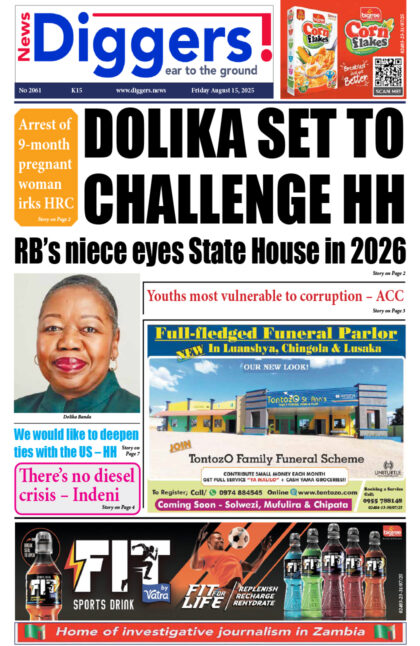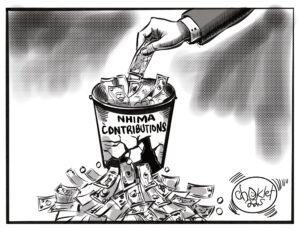TRANSPORT and Communications Minister Mutotwe Kafwaya says most parts of Zambia will receive normal to above rainfall in the 2020-2021 rainfall season.
Speaking in Parliament, Wednesday, Kafwaya however, said prolonged dry spells were likely to occur in some parts of North-Western, Muchinga, Luapula and Northern Provinces.
“Generally, a large part of Zambia is likely to receive normal to above normal rainfall. However, prolonged dry spells are likely to occur in some parts of North-Western, Muchinga, Luapula and Northern provinces. For the period October, November and December, 2020, much of Zambia will have a high chance of receiving normal to above normal rainfall, except for some parts of Chavuma, Zambezi, Kabompo, Manyinga, Mwinilunga, Ikelenge, Limulunga, Mongu and Kasama districts, which are likely to receive normal to below normal rainfall,” Kafwaya said.
“During the months of November, December and January, most parts of the country have a likelihood of receiving normal to above normal rainfall. However, Ikelenge, Mwinilunga, Kabompo, Senanga, Kabwe, Kapiri-Mposhi, Serenje, Chitambo, Lavushimanda, Mambwe, Petauke, Sinda, Katete, Kasenengwa and surrounding areas have a high chance of receiving normal to below normal rainfall. For December, January and February, much of Zambia has a high likelihood of receiving normal to above normal rainfall apart from Kasama, Mungwi, Chama, Lundazi, Chasefu, Petauke and Kalabo districts and, indeed, surrounding areas have a high chance of receiving normal to below normal rainfall.”
Kafwaya also announced that the 2020-2021 rainy season was likely to be fully established by the end of next month.
“In the last part of the season, January, February and March, 2021, most parts of Zambia will have a high chance of receiving normal to above normal rainfall. However, parts of Muchinga and Northern provinces as well as Mansa, Ndola, Kabompo, Senanga, Livingstone and surrounding areas are likely to receive normal to below normal rainfall. I wish to emphasise that every season has diverse implications across all sectors,” Kafwaya said.
“During the 2020/2021 rainy season, the country is likely to experience the following: dry spells across the country, especially over Luapula, Muchinga, and Northern provinces, including the northern districts of Eastern Province and increased chance for floods and flash floods in flood-prone areas. The 2020/2021 rainy season is likely to be fully established by the end of November, 2020, although in some areas, the rains may start earlier. Areas like Northern, Luapula, Copperbelt, North-Western and parts of Western provinces may experience thunderstorms and showers by October. In this regard, I would like to advise farmers and the public at large to safeguard their harvested crops properly to avoid damage.”
He added that the 2020-2021 rainfall forecast would equally be favourable to the southern part of the country.
“This year’s forecast is better in the southern half of our country than it was last year and the opposite is true for the northern half of the country. It is also important to note that in every season, dry spells occur in the middle of the rainy season and in certain circumstances, lead to crop loss. I would, therefore, urge our farmers and other stakeholders to regularly follow my Ministry’s regular meteorological forecasts and updates, which will be on most radio stations and television networks. They are also welcome to get in touch with the Ministry for them to access this information,” he said.
“Let me similarly state that there are other important aspects that come with the rainy season, which affect our daily lives and activities. In this regard, I wish to encourage sectors and communities to undertake sensitisation programmes in good sanitation and hygiene practices and clearing of drainage systems well in advance to avoid water pools that may serve as breeding grounds for germs. Likewise, there is need for institutions to stock relief materials, medicines and pesticides that may be required during the course of the season.”
And he called for more tree-planting as a measure to improve rainfall patterns.
“To protect our environment and contribute to mitigating the adverse effects of climate change and climate variability, I wish to encourage the public to plant trees. Trees are a natural measure to improve rainfall performance and reduce impacts of extreme weather conditions, such as floods and drought,” said Kafwaya.
“My Ministry will continue giving updates to the nation on the actual and expected weather conditions during the 2020/2021 rainy season through community radio stations, the Zambia National Broadcasting Corporation (ZNBC), including other communication platforms.”

























One Response
I am totally left confused with this weather update. How can Ndola, for example, in the middle of the Copperbelt have less than normal rainfall when the rest of the province has normal rainfall to above normal rainfall?! It’s unbelievable and I will pay particular attention to what really will happen in the named areas.